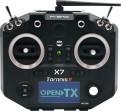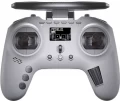Form factor
-
Gamepad. Remote controls in the gamepad form factor are supposed to be held with both hands. The controls in them are represented by buttons, levers, etc. The control elements are placed in such a way that they can be conveniently reached without changing (or almost without changing) the grip.
—
Rectangular (box). Advanced controllers for controlling RC models usually have a rectangular or almost square shape. This category includes both remote controls with a screen that occupies the lion’s share of the front part of the controller body, and models with an extensive set of control elements for maximum control of all parameters. Such remote controls are supposed to be held with both hands. Often their design includes a service display for telemetry (see “Telemetry support”).
—
Motion controller. Controllers for controlling the RC model using gestures and body movements. In most cases, they are devices held in the hand. Such remote controls have buttons and other traditional controls, but it is the movements tracked by the manipulator that play an important role. The action of the motion controller is often based on the use of mechanical sensors - an accelerometer and a gyroscope, but some models may include special additional equipment to improve accuracy.
—
Pistol. Remote controls of this form factor are h
...eld in the hand like a pistol—hence the name. In the overwhelming majority, such controllers are designed to control RC machines, special equipment and boats. The gas trigger in pistol controls is usually placed under the index finger, and on the side of the body there is a ring that is responsible for turning the RU model. These organs can be supplemented with other elements to control auxiliary functions.Display
The presence of a
display controller in the design and the type of installed matrix.
The screen in remote controls for RC models can play different roles. Thus, it is possible to display a picture from the camera in real time on a color display, and service parameters are often superimposed on top of it (for example, flight altitude, speed, remaining battery charge level, all sorts of service notifications, etc.). Monochrome screens are usually assigned other tasks - first of all, they are responsible for tracking telemetry (for more details, see the corresponding paragraph).
It is customary to equip advanced controllers for RC models with a display. Simple remote controls are often presented
without a display. And according to the types of matrices, there are the following screen options in controllers:
-
OLED. In the context of control controllers, OLED screens usually mean the simplest solutions with a black backing and white symbols for displaying settings and/or various service information. Such displays are based on organic light-emitting diodes, and their key advantage is the ability to easily read the displayed information in poor ambient lighting.
-
LCD. As a rule, these are the simplest monochrome screens - either segmented to display a limited set of characters, or based on a single-color
...LCD matrix, suitable for text and basic graphic information. LCD screens provide additional convenience: they can display various important data, for example, the flight altitude of a conventional quadcopter, the speed of movement of the RC machine, the signal level, the remaining battery charge, notifications of problems, etc.
- TFT. A TFT display means a screen consisting not of segments, but of full pixels and suitable for displaying various types of data: graphic symbols, images, and even streaming video from an installed camera. TFT screens provide the most extensive visualization of settings; they are used in controllers for controlling drones and other RC models in FPV (First Person View) mode.Screen size
Display diagonal size in inches. The larger the display, the more accurate and easier to read the information displayed on it, the better the video stream can be seen on the screen in real time. On the other hand, a display that is too large entails an increase in the size and cost of the controller. In remote controls with the ability to display only service parameters, the screen size is usually from 1 to 3 inches, in copies with full color matrices and support for broadcasting a video stream - about 5 - 7 inches diagonally.
Communication protocol
Communication protocol (standard) used by the controller to connect to the controlled RC model.
-
ELRS. An open protocol for wireless communications developed by the drone and amateur radio community. Express LRS comes in two frequency options: 868/915 MHz and 2.4 GHz. The goal of the protocol is to provide stable and reliable communications over long distances (up to 40 km) with low latency, which is especially important for FPV flights.
-
4in1. 4in1 is not a specific communication protocol, but the controller’s support for multiplatform. The same remote control can be used to work with multiple protocols, switching between them as needed. This is convenient for pilots who want to be able to control their drones from a single controller.
—
TBS Crossfire. A two-way wireless communication protocol developed and implemented by TBS (Team BlackSheep) to control copters and other remote control drones. Crossfire is known for its ability to maintain a stable connection over significant distances (often tens of kilometers), and the protocol also provides fast data updates with low latency and telemetry transmission, which is critical for FPV piloting.
-
TBS Tracer. Wireless communication protocol from TBS (Team BlackSheep) for use with the proprietary Tracer drone control system. The emphasis in this proto
...col is on performance and reliability in long-distance flights (including when piloting in FPV mode - first person). The Tracer system provides a long range, guarantees stable communication in conditions of interference, and is characterized by minimal data exchange delay, which increases the accuracy of drone control.
—FrSky. A proprietary protocol from FrSky Electronic, used in its radio control systems. Reliable communication is ensured over short and medium distances with low latency in data exchange between the controller and the receiver. At the same time, the ability to transmit telemetry has been implemented. There are several varieties of FrSky protocols, in particular, D8 and D16 (named for the number of supported channels), as well as the more modern FrSky ACCESS standard.
- FlySky. The FlySky protocol, developed by the company of the same name, ensures the transmission of control signals from the control panel to the receiver installed on the RU model. It is worth noting that there are two main branches of the protocol: AFHDS 2A, which works in the cheaper segment, and AFHDS 3A for more expensive models. Automatic Frequency Hopping Digital System automatically switches frequencies to minimize interference and ensure stable communications. Telemetry data is also transmitted along with control signals.External transmitter support
The option to connect an
external transmitter to the controller via micro or nano connectors allows for expanded functionality in managing RC models by supporting various communication protocols (see the relevant paragraph). For example, the default remote control operates on the TBS Crossfire protocol, while using an external transmitter allows for operation on the ELRS protocol.
Number of communication channels
The number of control channels provided in the radio-controlled model.
Each such channel is responsible for a separate function: pressing the gas pedal, rudder operation, climb, etc. For the simplest models of cars, boats and special equipment, two channels are enough; airplanes and helicopters will need at least 4 - 5 channels - for control of height, direction, roll, engine thrust and auxiliary functions. Drones often need even more channels. At the same time, thanks to the division into channels, there is a higher probability of finding a free subband within the main frequency. This is especially important in conditions of intense extraneous radio traffic and interference. Thus, advanced controllers for drones can provide as many as
16 communication channels.
Controls
The total number of controls in the remote control directly depends on the design, manufacturer, model and, most importantly, the purpose of the controller. This paragraph specifies all switches, buttons, sticks, sliders, scroll wheels and other elements used to control the RC model.
Gimbals
The controls are in the form of protruding levers that can be tilted in any direction. The sticks usually do not have fixed positions, which provides more “fine” control of the motion vector of the RC model. However, gimbals can also be used for other functions - in fact, everything depends on their implementation on board a particular controller.
— On Hall sensors. An advanced version of suspensions are solutions based on Hall sensors. The design of such levers is more reliable due to the absence of rubbing and contacting parts, and the position of the stick is determined by changes in the fluctuations of the magnetic field, which are monitored by appropriate sensors. Sticks on Hall sensors do not have “dead zones”, are devoid of the drift effect (misalignment), and wear out an order of magnitude slower. However, such solutions are not cheap.
- On potentiometers. Potentiometers change their resistance depending on the position of the control element, in this case the suspension. When the user moves the stick on the remote control, it actually changes the position of the potentiometer. These changes are captured by a variable resistor and used to generate an analog control signal. Sticks on potentiometers are less reliable due to the presence of rubbing parts.
In the box
—
Cover/case. Case for storing and transporting the controller. Cases are called soft cases - they are designed mainly to protect against dirt. Cases are made of hard materials - they are more bulky, but they are able to protect the remote control from impacts and shocks.
—
Protection of gimbals/sticks. Protective covers or casings that cover the controller's control elements (in particular, sticks) and prevent them from being accidentally pressed. Such devices will come in handy for safely storing and carrying the remote control.
—
A set of springs for suspensions. These controller gimbal kits typically come with several different spring options, allowing you to select the appropriate control stiffness based on the user's individual preferences. This provides greater flexibility and the ability to customize the control panel to suit specific needs and conditions of use.
-
Protective glass. Glass or transparent film to protect the remote control screen from scratches, dirt and mechanical damage. Protective glasses are tasked with keeping the controller display in good condition. This is especially important on models with touchscreens or color TFT panels, where scratches or damage can negatively affect the quality of the information displayed.

